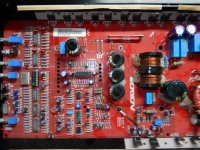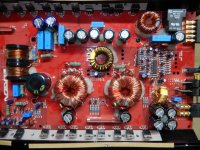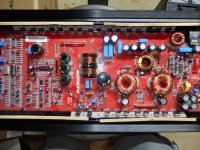Hello,
Resoldered a rfg40n10 @ Q203 and OK'd continuity. There's a soft-rhythmic clicking then the relay clicks loudly. No output and the power led remains steady red. Any clues to what it is?
Thank you for your time and consideration.
Resoldered a rfg40n10 @ Q203 and OK'd continuity. There's a soft-rhythmic clicking then the relay clicks loudly. No output and the power led remains steady red. Any clues to what it is?
Thank you for your time and consideration.
Attachments
What do you mean by:
OK'd continuity
Do you have a scope?
If not copy and paste the following list and post the DC voltage on the center legs of D61 and D64. Also post the DC voltage on all legs of Q211 and Q210.
OK'd continuity
Do you have a scope?
If not copy and paste the following list and post the DC voltage on the center legs of D61 and D64. Also post the DC voltage on all legs of Q211 and Q210.
Sorry sir, no oscilloscope. Just trying to repair my own stuff.
D61 -0.094 volts
D64 -0.094 volts
Q211 -0.096 volts/ 36.xx-37.xx volts/ -0.096 volts
Q210 -0.096 volts/ 53.xx-54.xx volts/ -0.096 volts
D61 -0.094 volts
D64 -0.094 volts
Q211 -0.096 volts/ 36.xx-37.xx volts/ -0.096 volts
Q210 -0.096 volts/ 53.xx-54.xx volts/ -0.096 volts
I apologize for dodging your question. Q203 looks like hell in the picture. I tested each leg of Q203 vs other parallel components/FETs with the continuity function on the DMM. The copper was pulled off the top of the board by the previous owner and wanted to ensure the soldering was good. I may have misused the term 'continuity'.
Center legs of the rectifiers:
D62 53.xx - 54.xx volts
D63 53.xx - 54.xx volts
I have no clue as to what the correct rail voltage is.
Center legs of the rectifiers:
D62 53.xx - 54.xx volts
D63 53.xx - 54.xx volts
I have no clue as to what the correct rail voltage is.
Last edited:
Have you operated all of the potentiometers and switches through their entire range with a speaker and signal source connected to see if you ever had any audio play through?
Things may have taken a turn for the worse. I hooked it up in my vehicle to a set of 4ohm woofers. My deck was set at zero volume. Hit the power, lights pulsed in the cabin at the same rhythm of the faint clicking in the amp, two 40A fuses on the amp blew. Took it back to the bench, plugged in two 15A fuses. Applied power, blew the 15A fuse inline with my power source. Jumpered the fuse block, then blew both 15A on the amp.
The amp was drawing about 1A idle when I first got it.
All I've got to limit current for further testing is a 10watt 10ohm resistor.
The amp was drawing about 1A idle when I first got it.
All I've got to limit current for further testing is a 10watt 10ohm resistor.
Last edited:
Was an insulator possibly damaged when the transistor was pulled up (or whatever happened to damage the connections)?
Don't have a clue. Bought it cheap and thought I could get up and going for my woofers. Guess I'll get a bit more experience out of this...
Pull that FET and see if it powers up?
Pull that FET and see if it powers up?
Check all of the components clamped to the heatsink to see if any center terminal reads 0 ohms to the heatsink. Make sure that you have one probe on a bare place on the heatsink. A screw hole where the screw has cut through the anodizing is generally a good place for the probe. The components need to be clamped as they normally are.
Dangit. I can put it all back together and follow your instructions.
I already tore it apart, put a 10ohm resistor in series with +B. Read 1.1A draw and no power to led. Then proceeded to pull Q203 (REP40N10). No change in current draw. Next I pulled Q42 (IRF3205). The current dropped enough to where I felt I could power the amp without the 10ohm resistor. The led is now powered on, and the relay clicked. I still hear a faint-rhythmic clicking somewhere.
I already tore it apart, put a 10ohm resistor in series with +B. Read 1.1A draw and no power to led. Then proceeded to pull Q203 (REP40N10). No change in current draw. Next I pulled Q42 (IRF3205). The current dropped enough to where I felt I could power the amp without the 10ohm resistor. The led is now powered on, and the relay clicked. I still hear a faint-rhythmic clicking somewhere.
What is the pot on the board, to adjust the bias? Did the previous owner mess with this?
Can anyone confirm that REP40N10 and IRF3205 are the original components?
Can anyone confirm that REP40N10 and IRF3205 are the original components?
Last edited:
Ok, I'm starting to nip this thing in the butt.
Found out Q201 (RFP40N10) was shorted. Pulled it , applied power, and now the faint-rhythmic clicking has stopped, led still lit. Q42 (IRF3205) also shorted.
Should I rebuild both the audio and PS?
What's a substitute for the obsolete RFP40N10?
Found out Q201 (RFP40N10) was shorted. Pulled it , applied power, and now the faint-rhythmic clicking has stopped, led still lit. Q42 (IRF3205) also shorted.
Should I rebuild both the audio and PS?
What's a substitute for the obsolete RFP40N10?
It will function with only those out of the circuit.
Did you try what was suggested in post #6? Do not operate it without having everything clamped down.
The 3205 probably isn't original. You can generally tell OEM solder connections from hand soldered connections.
The IRF3710Z (MUST have Z) should be OK for the outputs. The 3205 is OK for the power supply.
Do NOT (VERY important)... Do NOT buy the transistors from ebay. Digi-key and mouser are good suppliers. NOT ebay.
Did you try what was suggested in post #6? Do not operate it without having everything clamped down.
The 3205 probably isn't original. You can generally tell OEM solder connections from hand soldered connections.
The IRF3710Z (MUST have Z) should be OK for the outputs. The 3205 is OK for the power supply.
Do NOT (VERY important)... Do NOT buy the transistors from ebay. Digi-key and mouser are good suppliers. NOT ebay.
I did try #6, I ended up shorting out the amp. The cabin lights pulsed and blew the 2 40A fuses. Then I was unable to power up the amp until I removed Q42.
Do I need to change the gate resistors when using the IRF3710Z?
Is the delicate 20 pin IC ok? I have no idea what it is because manufacturer sanded the numbers off.
Do I need to change the gate resistors when using the IRF3710Z?
Is the delicate 20 pin IC ok? I have no idea what it is because manufacturer sanded the numbers off.
The 20 pin IC is an HIP4080. If the amp functions without the shorted IC, the 4080 is likely OK.
Doing as suggested in #6 will cause no harm unless something is wrong with one of the controls or the circuit they're connected to. It still has to be done.
Many times, the only reason that an amp is not producing audio is due to a dirty switch contact or dirty/damaged potentiometer. Before doing any work on an amp that's powering up, checking the pots and switches will reveal that the problem is simple and requires no repair of the amp.
The gate resistors don't generally need to be replaced (unless out of tolerance) for amps that use the 4080.
Doing as suggested in #6 will cause no harm unless something is wrong with one of the controls or the circuit they're connected to. It still has to be done.
Many times, the only reason that an amp is not producing audio is due to a dirty switch contact or dirty/damaged potentiometer. Before doing any work on an amp that's powering up, checking the pots and switches will reveal that the problem is simple and requires no repair of the amp.
The gate resistors don't generally need to be replaced (unless out of tolerance) for amps that use the 4080.
Please don't post in a repair thread that was started by someone else unless you are trying to help them.
I don't understand the question, rephrase it but in a new thread. Include a link to this thread if you want to reference it.
I don't understand the question, rephrase it but in a new thread. Include a link to this thread if you want to reference it.
- Status
- Not open for further replies.
- Home
- General Interest
- Car Audio
- XTRPRO 1000 - No Output


